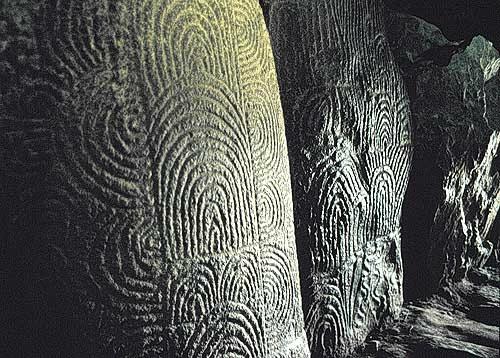 |
| Border Collies herding sheep in 5000-year-old Neolithic enclosure in the Burren, County Clare, Ireland |
Angus Marshall-Smith is the sheepdog in our family and did not get to come along on my sister Kitty's visit to Ireland. However, Kitty and I were excited when we learned of sheepdog demonstrations at Caherconnell Stone Fort and Sheepdog Demonstrations. (If you follow the link, they have a little video of the dogs herding sheep.) We rushed on over despite the unseasonably cold weather. About 30 miles from where we are staying near the Atlantic, it is on the eastern edge of the Burren among many of the very important Neolithic archeological sites, but those are posts for a different day. To our delight, the field where the demonstration was held was part of the Neolithic living complex, inhabited from about 5000 years ago by people who herded sheep and cattle, too.
John Darven was our host and was as careful of us as of his sheep and dogs. His family have been running sheep and cattle at this site for 300 years, and he hopes the next generation can carry on too.
Three dogs were working: Sally, emeritus, is an 18-year-old collie/cattle dog mix whose job was to watch over the visitors in the shelter. Not that hard--we were the only visitors. The other two dogs are border collies: Lynn, 8-years-old and master of her craft; and Lee, 4-years-old and still learning though quite skilled. They were the ones who herded the sheep at John's commands.
John tells us that the dogs learn voice commands first and within about 6 weeks can follow the easy ones like left or right. Once they learn to follow voice commands they learn to follow whistles since they work out in the hills and may be as much as a mile from the shepherd. Each dog knows her own name and each has a unique whistle note so each dog can be told to do a different thing.
When out in the Burren for pasture, the sheep do not need to be watched constantly. But for lambing season, generally February and March, the dogs stay with them to guard against predators. Foxes and pine martens are the main worry and are enough of a problem that sometimes people also have to stay with the lambs.
This farm is a dairy farm too and dogs like Sally herd the cows using a different, more forceful technique. Since the season is unusually cold and wet the cows are still in the barns being fed rather than being able to go out to grass as they should be doing in May. Visitors do not require a forceful technique and Sally was kindly toward us. We noted that visitors can usually plan on a little sun too and John agreed that the tourist-trade is way down because of the weather. The rain is only good for Sally since she only has a few tourists to watch over and can take it easy.
 |
| Sally is a collie/cattle dog mix, 18 years old. She gets to stay in the shelter with us while her two younger co-workers herd sheep for us. |
 |
| We have a shelter for watching but it is pretty windy and rainy anyway. Sally's job is to watch over us. |
 |
| Sheep are in a stone-enclosed yard which contains remnants of the Neolithic farmstead. They are herded through a series of fences and back to the center. |
 |
| More sheep, more Neolithic remains. The sheep are far away so have to be guided by whistles rather than voice. |
 |
| Bringing in the last sheep to the field pen. The dogs go around in opposite directions to get them to bunch up. |
 |
| Sheep in the field pen which is part of the Neolithic stone fort. (Sorry--too rainy to walk out to photograph the major remains.) |
 |
| Looking for the one who got away. |
 |
| Got it. |
 |
| Sheep successfully penned, keeping a wary eye on the dogs. |
 |
| We are able to get in out of the rain and dry off. Kitty drinking tea; raincoats dripping. As soon as we finished our tea, the sun came out. |
 |
| Angus, home in Alaska, waiting for a called-in report on the sheep. |

_lge.jpg)





























